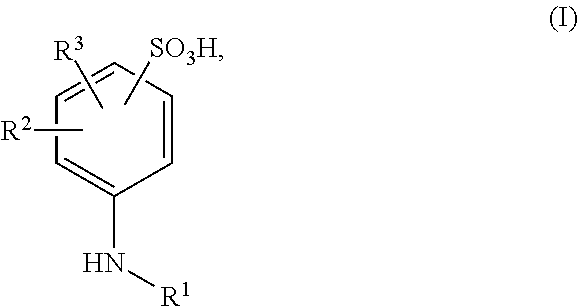Ionically hydrophilized polyisocyanates and antioxidants
a technology of hydrophilicity and polyisocyanates, applied in the direction of dyeing process, non-macromolecular adhesive additives, adhesive types, etc., can solve the problems of high polyether content, polyether modification of polyisocyanates, permanent hydrophilicity of the obtained coating, etc., to improve the incorporability of aqueous systems, reduce colour number, and reduce the effect of viscosity
- Summary
- Abstract
- Description
- Claims
- Application Information
AI Technical Summary
Benefits of technology
Problems solved by technology
Method used
Image
Examples
example 1 (
Non-Inventive)
[0155]957.3 g (4.95 val) of the isocyanurate group-containing starting polyisocyanate A1) were stirred together with 27.1 g (0.12 val) of 3-(cyclohexylamino)propanesulfonic acid (CAPS) and 15.6 g (0.12 mol) of dimethylcyclohexylamine at 100° C. for 6 hours under dry nitrogen. After cooling to room temperature, a largely clear polyisocyanate mixture containing sulfonate groups was present. After filtration over a T 5500 filter layer (Seitz), the following characteristic data were determined:
[0156]NCO content: 20.0%
[0157]NCO functionality: 3.3
[0158]Viscosity (23° C.): 7410 mPas
[0159]Color number (Hazen): 65
[0160]Emulsifiability (MPS): 468 nm
example 2 (
Inventive)
[0161]To 957.3 g (4.95 val) of the isocyanurate group-containing starting polyisocyanate A1) were added 0.2 g (200 ppm) of antioxidant D1) and the mixture was then stirred together with 27.1 g (0.12 val) of 3-(cyclohexylamino)propanesulfonic acid (CAPS) and 15.6 g (0.12 mol) of dimethylcyclohexylamine at 100° C. for 6 hours under dry nitrogen. After cooling to room temperature, a largely clear polyisocyanate mixture containing sulfonate groups was present. After filtration over a T 5500 filter layer (Seitz), the following characteristic data were determined:
[0162]NCO content: 20.2%
[0163]NCO functionality: 3.3
[0164]Viscosity (23° C.): 6840 mPas
[0165]Color number (Hazen): 14
[0166]Emulsifiability (MPS): 223 nm
[0167]The comparison of examples 1 (non-inventive) and 2 (inventive) shows that the inventive hydrophilic polyisocyanate produced in the presence of an antioxidant at otherwise identical product composition has a higher NCO content, a lower viscosity and colour number an...
example 3 to 16 (
Inventive and Comparative)
[0168]Different polyisocyanates A) were reacted with aminosulfonic acids B) in the presence and absence (respective comparison) of different antioxidants D) according to the process described in example 2. Table 1 below shows the composition of the reaction mixtures in parts by weight, the amount of antioxidant used in ppm based on the respective total amount and also the characteristic data of the products obtained.
TABLE 1Example9345678Comparative10Starting polyisocyanate A1)[parts by weight]957.3957.3957.3957.3957.3957.3956.2956.2Starting polyisocyanate A2)[parts by weight]————————Starting polyisocyanate A3)[parts by weight]————————Starting polyisocyanate A4)[parts by weight]————————CAPS[parts by weight]27.127.127.127.127.127.1——CABS[parts by weight]——————28.228.2Dimethylcyclohexylamine[parts by weight]15.615.615.615.615.615.615.615.6MPEG 500[parts by weight]————————Butyl acetate[parts by weight]————————Propylene glycol diacetate[parts by weight]————————A...
PUM
| Property | Measurement | Unit |
|---|---|---|
| mol % | aaaaa | aaaaa |
| mol % | aaaaa | aaaaa |
| temperatures | aaaaa | aaaaa |
Abstract
Description
Claims
Application Information
 Login to View More
Login to View More - R&D
- Intellectual Property
- Life Sciences
- Materials
- Tech Scout
- Unparalleled Data Quality
- Higher Quality Content
- 60% Fewer Hallucinations
Browse by: Latest US Patents, China's latest patents, Technical Efficacy Thesaurus, Application Domain, Technology Topic, Popular Technical Reports.
© 2025 PatSnap. All rights reserved.Legal|Privacy policy|Modern Slavery Act Transparency Statement|Sitemap|About US| Contact US: help@patsnap.com



